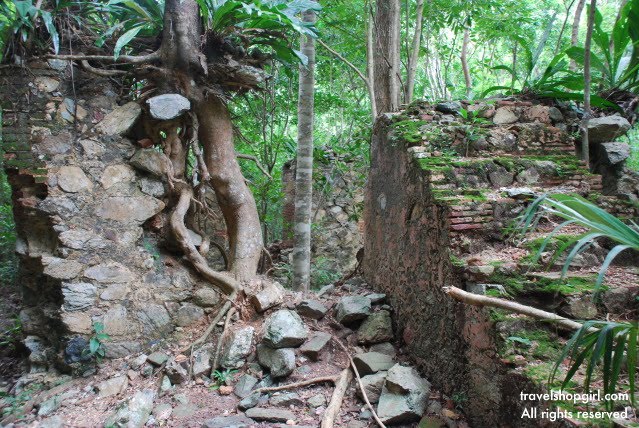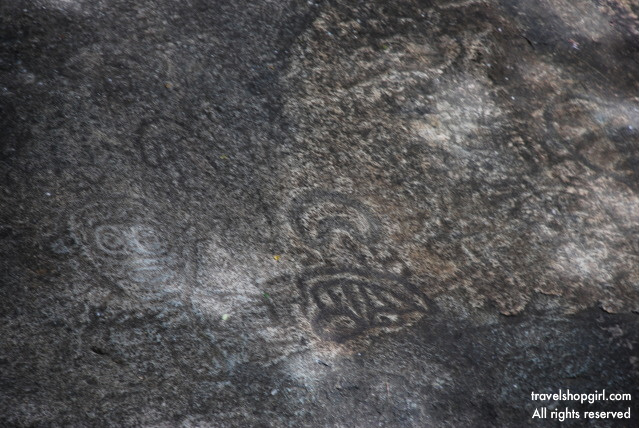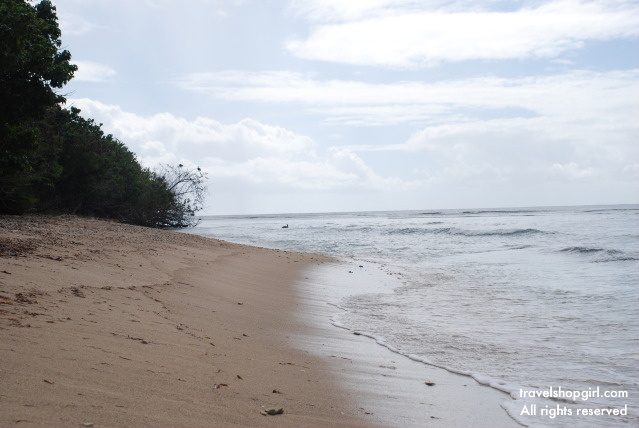When I was planning my trip to the US Virgin Islands, I went to the US Virgin Islands web site to learn more and to help me best plan my trip. Of the three islands I was to visit, St. Thomas, St. John, and St. Croix, St. John was the only island I had never been to previously. Therefore, checking out the web site, I found the one activity I knew I just had to do:
Reef Bay Trail & Petroglyphs: The most popular trek in the National Park, this trail begins on Centerline Road and descends 937 feet through a shady forest. While hiking, you encounter the visible remains of four sugar estates and ancient petroglyph rock carvings. The trail ends at the Reef Bay Plantation ruins near Genti Bay.
How could I pass that up? As someone who likes a good challenge and an adventure, Reef Bay Trail was the perfect way to spend my Sunday. My driver picked me up at the Westin St. John Resort and we drove over to Centerline Road to get to the start of the trail, which is 4.9 miles east of Cruz Bay. The well-maintained trail descends 937 feet from the road to the floor of the Reef Bay Valley. The average hiking time is two hours downhill from Centerline Road to the beach. As I walked down the set of steps to the start of the trail, I took this picture detailing the trail and how it is laid out.
The trail descends through a changing forest. During plantation days, trees were leveled for cane fields and charcoal. Most of St. John’s vegetation is second and third growth. But in this high, steep valley — never totally cleared — you can get a sense of the island’s original subtropical forest. As you hike, notice other changes in the forest (the upper valley catches more rainfall). You may glimpse remains of farms and sugar estates, half concealed by the vegetation.
The start of the hike began around 9:30 am on Sunday and for the duration of my hike down, I saw a total of four other people the entire time. That doesn’t include the woman and her little boy who walked a few feet into the trail and then promptly turned around and walked back out. Her husband and other son continued, but didn’t go the whole way into the trail as they ended up walking back up and past me a short while later. On the way back up is when I started to see people, but more on that later. I definitely recommend bringing water and wearing comfortable shoes and clothing for this hike as the air was thick and damp from the humidity. My driver, Kenneth Louis, was kind enough to stop and buy me a bottle of water at the start of the day and that felt cool against my back as I walked. I wore my Teva sandals, which I liked better than wearing sneakers. As you can see in this picture, there are large portions of the trail that are flat and easy to walk and are a welcome after the long downhill stretches, which later become the much harder uphill stretches.
From the stjohnbeachguide.com: “The top section of the trail descends steeply through the moist sub-tropical forest of Reef Bay’s upper valley where there is an abundance of large trees, such as locust, sandbox, kapok, mammee apple and mango. National Park information signs along the way will provide valuable information about the natural environment of the valley. The ruins of the Josie Gut Sugar Estate can be found about a half mile down the trail. The plantation began operation in the early eighteenth century. The circular horsemill, supported by an old stone retaining wall, is still in good condition. A small storage room was built into the lower portion of the retaining wall. The boiling room, now in a state of ruin, lies right below the horsemill, just a few yards off the trail.”
About halfway down you’ll see the sign for the Petroglyphs, one of the main attractions on the trail. It is about 0.22 miles off the main trail and it is a freshwater pool formed by the Living Gut provides the location of the ancient Taino rock carvings, which are called the petroglyphs. Civilizations lived on St. John long before the Europeans arrived to the region, as evidenced by the petroglyphs. The Taino people were all but driven into extinction by Europeans in the 17th century seeking new territories as colonial properties. The area by the petroglyphs is where you can take a break, go swimming under the waterfall, or just relax before heading back out on the trail.
When you return from the Petroglyphs, you have a choice whether to continue straight on the Reef Bay Trail or head left toward the Lameshur Bay Trail. As the trail nears the sea it passes through a low-lying marshy area. At first you might see one or two holes in the ground and than many, which are land crab holes. This area was once popular for gathering these island delicacies. Land crabs are now protected within the National Park boundaries and hunting them is forbidden. I did see, however, an ambitious little mongoose and I suspect that he probably didn’t read the “no hunting crabs” sign. Be careful when walking through this area because the crabs will be everywhere and you really don’t want to inadvertently kick or step on one by accident.
As you continue walking, you’ll then come upon the Reef Bay Sugar factory, one of four sugar estates on this trail. Walk around the buildings and take in the history From the seestjohn.com web site:
After the abolition of slavery in the Danish West Indies, the sugar industry on St. John began to collapse. Most of the sugar plantations on St. John were sold, and their new owners switched to cattle raising or provision farming. The owners of Reef Bay, however, decided to continue the sugar operation. To make the process more economically feasible, they installed a steam engine to power the rollers. This, they felt, would solve the problems associated with the slowness of animal power. In 1916, St. John was struck by a major hurricane. The factory was closed and the sugar era on St. John finally came to an end. By 1930, only five people lived in the Reef Bay Valley at Par Force. They tended two acres of provisions and grazed 44 cattle. Reef Bay remained sparsely occupied until the early 1950s. In 1955, much of Reef Bay was sold to the Rockefeller’s Jackson Hole Preserve Inc., which transferred the land to the National Park.
One quick note: There are no bathroom facilities until you reach Reef Bay Sugar factory. When then First Lady Ladybird Johnson went on the trail in the early 1960’s, there were no bathrooms available. She later donated money for the construction of the bathrooms currently on the trail, which are housed in cinderblock buildings and are no more than basic outhouse-type facilities so plan accordingly before you go on the trail if you aren’t one to like this type of accommodation.
Should you decide to do this hike, plan sufficient time to do it. If you go on your own, the recommendation is 2 hours each way. As I tried to figure out the exact length of the trail, I discovered that the length varies according to the source, but some say 2.2 miles each way while others say 2.4 miles each way. While on the trail, at the halfway point by the petroglyphs, the sign said 1.8 back to Centerline Road and 1.8 miles to the end of the trail at Reef Bay beach. Lots of people choose to take the trail hike with a guide offered by the Park Service, which costs $23 per person. You’ll get a thorough explanation of everything along the way and upon arrival at Reef Bay beach, you simply hop into a boat for your boat ride back to Cruz Bay. If you choose to do the trail on your own, you’ll need to make your way back up the length of the trail all on your own so go for a swim, have a little lunch, and enjoy the view before beginning your hike back up to your car.
On the way back up the trail, I started to see more people and assumed that these people were doing the hike down/boat back combo, but you should know that the Park Service guided tour is not available every day and you will definitely need to call ahead to make your reservation. When I tell you that the climb back up the trail was more difficult than the walk down, I’m not joking. I truly didn’t appreciate the drop in elevation and how difficult the rocky terrain can become when you are starting to get tired. The areas of flat, easy paths magically disappeared and were replaced with constant uphill climbs. When you are near the upper half of the trail, either on the way down or on the way back, the rocks can be slippery so be careful. This picture that I took makes the trail appear level, when in fact it wasn’t at this point and it was beginning to go uphill from here. I wish I had taken video to show how the actual trail looked because the pictures make it look like a simple little hike in the woods. I was glad that I had taken pictures on the way down so I could track my progress back up and determine where on the trail I actually was. Over the next few weeks I intend to put the rest of the pictures from my hike on my FaceBook page so if you’d like to see more images, check out the Travel Shop Girl FaceBook page and click on the photos link. For experienced hikers, you might not find Reef Bay Trail terribly challenging. However, for people who don’t exercise and aren’t used to exercise of any kind, you might want to think this through before committing to it. I thoroughly enjoyed the hike and wouldn’t hesitate to do it again the next time I’m in St. John.
UPDATE 1/23/12: Friends of VI National Park have issued an update on how to book a trail hike with the National Park Service. If you would like more information, visit my latest blog post to get the updated information.













What a gorgeous hike!
This is a great description of Reef Bay hike which is a favorite of ours. We especially like to take the National Park Service boat back to Cruz Bay! I hope it is OK to post this description on our website’s ‘hiking’ page which describes the variety of hiking options on St John: http://www.greatexpectationsusvi.com/st-john-usvi/outdoor-activities/Hiking
Thanks for such a great description of the hike and the history! Very well done. I enjoy going to the Petroglyphs and hope to do it on my trip next month. Will link from our site as well -jim
Thank you to both Kristin and Jim for complimenting me on my blog about Reef Bay Trail. I hope if anyone is looking to stay in St. John that they will consider renting a villa and not just think about a hotel stay.
One of my favorite hikes in the Virgin Islands National Park. The other one is the Brown Bay Trail. It’s a bit shorter and you end up at a wonderful little beach with plenty of sea grape shade and some interesting ruins on the western end of the beach.